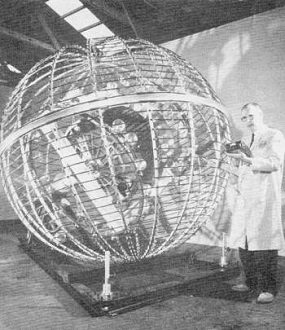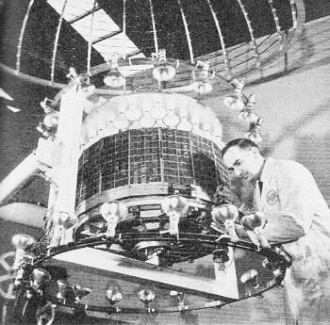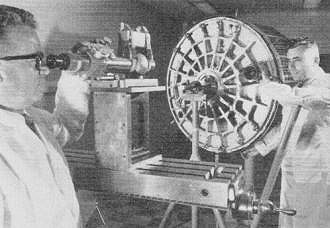February 1961 Popular Electronics
 Table of Contents Table of Contents
Wax nostalgic about and learn from the history of early electronics. See articles
from
Popular Electronics,
published October 1954 - April 1985. All copyrights are hereby acknowledged.
|
Television Infrared Observation
Satellite (TIROS) was the first platform for space-based weather observation, both
in visible and infrared wavelengths. All modern satellites have attitude and orbit
correcting capabilities via gas jets, but there is only a limited supply of gas
available so the lifetime of a satellite is limited as well. Scientists who monitored
the performance of TIROS I noticed that the Earth's magnetic field affected
the satellite's attitude as it orbited. They reasoned that attitude control coils
could be installed and energized on TIROS II using electrical power from its
solar panels rather than the onboard fuel supply - pretty darned clever. This article
from a 1961 edition of Popular Electronics magazine describes the effort.
Tilting TIROS II
Magnetic "hand" tilts space satellite

Spherical "cage" designed to produce magnetic fields resembling
those of the earth was used in pre-launching tests of Tiros II. Here, Warren
P. Manger, of the RCA Astro-Electronics Division, takes reading of magnetic effect
within the wired "cage," preparatory to rotating the satellite on its mount for
study of the orientation system.

Magnetic orientation system being tested at RCA's Space Center
in Princeton, NJ. Lights above and around the satellite are used to check operation
of solar cells which surround satellite.
The nation's latest "weather-eye" satellite, "Tiros II," has achieved a
major "first" in space. By means of a remote-control system, ground observers can
tilt the satellite in space for improved TV coverage of clouds above the earth.
Developed by the Radio Corporation of America, the new orientation technique
uses the effect of the earth's magnetic field to alter the "attitude" of the satellite
upon command - without the need for special propulsion devices. This technique was
the outcome of studies by RCA and government scientists of an unexpected gradual
shift in the attitude of the first Tiros satellite under the influence of the magnetic
field surrounding the earth.
In the first Tiros, which returned nearly 23,000 useful TV cloud pictures to
earth following its launching last April, these magnetic forces caused the satellite
to tilt gradually away from the predicted position of its axis in space. In Tiros II,
the forces are being harnessed by a controllable magnetic field generated around
the satellite itself by wire coils on the lower sides of the vehicle. Interacting
with the earth's magnetic field, this controllable field gives ground observers
an invisible "hand" to tilt the satellite on command, in order to obtain a more
advantageous angle.
Equipped with the orientation-control system and with newly developed infrared
instruments to measure the emission and reflection of solar heat by the earth and
its atmosphere, Tiros II represents the second step in the experimental weather
satellite program being conducted by the National Aeronautics and Space Administration
to study the feasibility of regular satellite weather operations.
Among the major features common to both the Tiros I and II satellites are
electronic clocks that control the timing of cameras, tape recorders, and infrared
systems during each orbit; more than 9000 solar cells on the top and sides of the
satellite to convert electrical energy for operation of the electronic systems;
"yo-yo" weights which slow the satellite's spin from 120 rpm to 12 rpm as it enters
orbit; and five pairs of solid-fuel spin-up rockets to restore spin momentum.

Wide-angled television camera on Tiros II is checked by Sidney Sternberg,
and Ralph Jordan at the RCA Space Center. Tiros II, mounted on its side in
this photo, is identical in external appearance to Tiros I.
Posted December 19, 2022
(updated from original
post on 11/1/2012)
|











